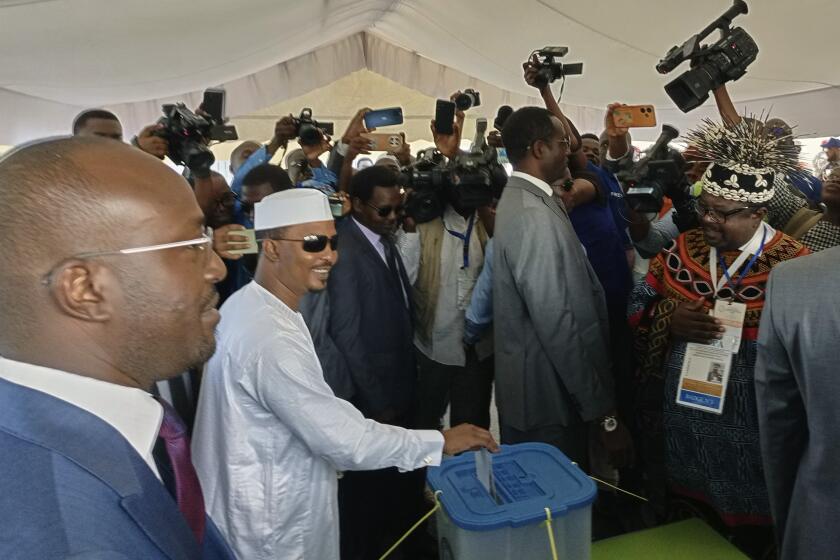PACIFIC REPORT : Curing a Copycat Syndrome : Technology: Shortcuts to product development have left South Korea behind other nations in technology. It is now pouring more money into research.
In the low, rolling hills here behind the city of Taejun, 100 miles north of Seoul, is a spacious research park marked by wide, empty roads winding past soccer fields, parks and an occasional fenced-in government compound. After the bustle of Seoul, it feels almost deserted. It nearly was.
Taedok Science City was planned 18 years ago on the model of Silicon Valley to be a “cradle” of research, bringing together the best Korean minds from academic, government and private research institutes. Instead, after a few laboratories were built on site, the idea languished.
Korean industry was too busy putting up new factories and shipping out products to worry about doing research.
“Companies just imported entire factory lines,” says Park Song Bai, a professor of electrical engineering at Korea Advanced Institute of Science and Technology, one of the institutes that chose not to set up shop at Taedok. “They put materials in one end and took products out at the other end.”
The only Korean input? Cheap labor.
Now, Korea’s neglect of technology has come back to haunt it. Labor costs have skyrocketed, and Korean electronics exports, which more than tripled to $16 billion in 1988 from 1985, have barely grown in the past two years. Exports of videocassette recorders have fallen.
The result of this neglect of technology: After initially welcoming Korean products to the market, consumers have been disappointed by their quality and lack of important features. The failure to train workers in production techniques has made it difficult for companies to keep upgrading their factories to cut production costs at the rate of their competitors in Japan.
If Korea cannot produce much more cheaply than its competitors, or produce products at least as innovative, it could find its products stuck on the discount shelves while Japanese companies take all the fast-growth, high-profit business. Although Korean exports are showing signs of recovery in some areas, Japanese manufacturers sneer that Korean sales are limited to the low-profit end of every product line. In televisions, Japanese makers contend that Korean companies are competitive only at the 13-inch level and have been virtually cut out on the more profitable market for big-screen televisions.
In an effort to reignite its exports, Korea is finally making a serious effort to boost its research and development. Last month the government announced a comprehensive plan that includes a dramatic increase in the number of university slots for engineers and a $2.1-billion, five-year plan--half financed by the private sector--to develop such critical technologies as memory chips and high-tech auto components.
“Korea can only experience takeoff (in economic growth) again with breakthroughs in technology,” says Lee Kyung Tae, economist at the Korean Institute of Economics and Technology, a government think tank. “It takes money, manpower and accumulated knowledge and experience. It takes time.”
Korean executives recognize that their shortcuts weren’t getting them anywhere.
“We discovered that by copying Japanese products, we are too late to get to market,” says Kwon Seung-Han, executive managing director of Samsung Electronics’ consumer electronics research effort. “Developing your own technology takes more money and more risk, but copying is no longer profitable.”
Kwon’s boss, Samsung Chairman Lee Kun-hee, said it even more forcefully in a speech late last year: “It doesn’t matter whether we are behind our competitors in the advanced countries by one year or three years in high technology. The very fact that we are inferior to them threatens our very existence.”
Korea is unlikely to ever completely close the technology gap with its competitors. Total Korean spending on research and development this year will be roughly $5 billion, about 25% of that from the government. That is double the 1987 level but still less than what International Business Machines spends on research in a year and 1/15th Japan’s research budget.
But then, nobody is talking about producing Nobel Prize winners. What Korea wants to develop is the kind of technology that’s necessary to design and manufacture commercial products.
Ironically, such a goal may require some Korean scientists to lower their sights a little. Only science with a clear industrial market is welcome in Korea, officials say.
“Instead of trying to develop magnetic levitation trains or basic science, we should focus on building things like the head drum of VCRs,” says Kwon Moon Yong, in charge of coordinating technology policy at the Economic Planning Board, referring to a key component in videotape recorders. “Companies haven’t been able to keep up with some of the things being done by research institutes.”
The goal, simply put, is to reduce dependence on Japanese and American components and licenses. Of the production cost of a personal computer, for example, 80% is taken up by imported parts and licenses. “We must pay 10% of total sales of VCRs for technology for patents,” Kwon says. “That is terrible.”
Filing more patents is another goal. With more patents, Korean companies could engage in technology exchanges with other firms and cut their royalty bill, which climbed to $1 billion last year, up 22% from 1989. Samsung expects to apply for 500 patents this year, up from 200 last year.
Finally, Korea needs to make better use of the wealth of research from the rest of the world, officials say. Bae of Daewoo says more bluntly, “We need to develop the capability to take published information and use it.”
The government is trying to focus university efforts by building centers of excellence based on specific technologies such as sensors, an idea put forward by the U.S. National Science Foundation to encourage the development of certain kinds of expertise in a single research community.
Korea is also taking a page from Japan’s Ministry of International Trade and Industry by creating consortia of government, university and industry laboratories to do research in areas such as communications, high-definition television and liquid-crystal screens.
Korea’s first real success with joint research was the TDX-10, a digital telephone switch developed jointly by industry and government research institutes with backing from the Korean public telephone company.
Another widely cited success story was the development of 4-megabit dynamic random access memories (DRAMs), advanced memory chips that are just beginning to sell in large quantities and in which Korean firms expect to take a major share.
For all the government research projects, 75% of Korea’s research spending is in the private sector. And that is where scientists agree that Korea’s hope lies.
Korean corporations aren’t resting on their laurels. By the end of last year, Korean companies had built 941 laboratories, up from just 54 in 1980. But with few experienced researchers and limited budgets, much of the research remains simple reverse engineering.
“If you go and look at the equipment and talk technical subjects with the researchers, you realize what low quality the research is,” says Park of the Korean Advanced Institute of Science and Technology.
Park has nothing against reverse engineering--if it’s done right. He likes to dabble in it himself. When Park saw that the domestic demand for ultrasound diagnostic equipment would soar, requiring Korea to put out precious foreign exchange for the machines, he decided to tackle the problem himself.
“I took apart Japanese machines to see how they worked; it is faster that way.” However, rather than simply imitating the Japanese products, he worked to improve the product to provide sharper computer images.
When Korean industry showed no interest in the product, one of Park’s best students, Lee Min-hwa, took up the challenge. Sales have boomed since Lee established his company, Medison, in 1985. He now has manufacturing facilities in India, Brazil and China, and will soon begin manufacturing in the Soviet Union.
It is success stories such as these that Korea wants to see more of when it talks about promoting research.
“In the West, the idea was that scientists make it known and the engineers make it useful,” says Lee El-Han, a former Bell Labs scientist who is director of research at the Electronics and Telecommunications Research Institute, the nation’s premier laboratory in electronics research. He says Koreans first look for a good market and then ask their engineers to make the product. Only when the engineer faces limitations are the scientists called in.
Lee is concerned that the approach could prove shortsighted as technology merges with basic science in a growing number of fields. Developing the next-generation memory chip, the 64-megabit DRAM, for example, will require a great deal of basic research in materials, he says.
“Basic science is the infrastructure for technology,” agrees Chung Myung Sai, vice president for research and development at the Korea Standards Research Institute in Taedok. “You can’t just expect to find people who know the theory behind a few narrow fields.”
There are a few examples, however, of breakthrough research, and they have become the pride of Korea, quoted in newspapers when the topic of research comes up.
One such example comes from the Taedok research lab of chemical producer Lucky Ltd. Researchers were going through the tedious process of testing hundreds of different compounds when they unexpectedly struck gold--a substance that appeared to be more powerful than any antibiotic now on the market.
In January, Lucky announced that it would license the product to Glaxo, a British pharmaceuticals firm. “They have the second-best-selling antibiotic in the world, and they told us ours is better,” Oh Hun-Seung, managing director of the research center, says proudly.
Oh admits that a great deal of luck was involved in the research. And it was a fundamental change in Korean patent law, not farsightedness, that drove it to be more inventive.
Until 1987, a Korean chemical company was allowed to reproduce an American product without paying license fees if it simply developed a slightly different process for manufacturing the product. Now the product itself must be different, or companies must pay license fees to the original developers.
All this emphasis on technology may yet make Taedok a cradle of Korean science. Companies are finally getting more serious about setting up research labs and are looking to Taedok as the ideal location.
By the end of next year, when an international exposition is scheduled for the site, Taedok should be a far livelier place. While only 20 institutes are open now, 61 are expected to have made their home in the science city by then.
SOUTH KOREA’S ELECTRONICS EXPORTS South Korea became known in the late 1980s for its rapid growth in exports of consumer electronics products such as videocassette recorders and color television sets. But as the figures below show, export growth in some of these products has slowed, and has actually declined with VCRs.Source: Electronic Industries Assn. of Korea
PRODUCTIVITY: JAPAN BEATS KOREA
Production per person per year
Korea Japan Color TVs 4,000 units 7,300 units Autos 19.3 cars 58.5 cars Steel 463,000 tons 634,000 tons Ships $20,000 $50,000
Production per person per day
Korea Japan Color TVs 11.8 29.6 Cassette recorders 15.7 42.1 Stereos 5.7 15.7 Washing machines 8.2 19.7
Source: Korea Economic Planning Board report on automation.
More to Read
Start your day right
Sign up for Essential California for news, features and recommendations from the L.A. Times and beyond in your inbox six days a week.
You may occasionally receive promotional content from the Los Angeles Times.






